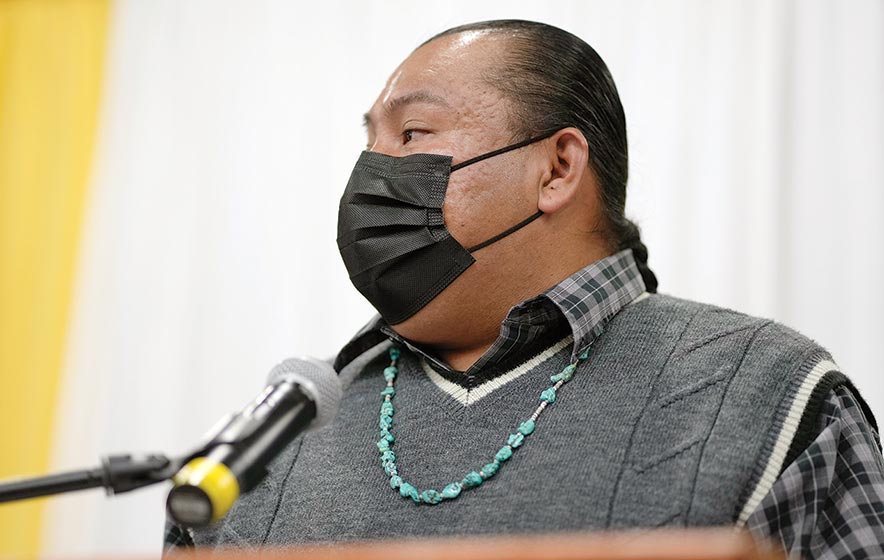
Traditional background shaped Cody’s life

Navajo Times | Donovan Quintero
Candidate for president Kevin Cody from Bááhááli, N.M., responds to a question during the candidate’s forum at Diné College in Tsaile, Ariz.
TSÉBIGHÁHOODZÁNÍ
Watching his father endure miles to put food on the table and growing up alongside his elders shaped Kevin Cody’s life.
Long-distance was difficult for Cody but spending time with his family at the end of the week made it all worth it when he was young.
Cody was born on Sept. 10, 1980, in Na’nízhoozhí, but he grew up off the grid in Piñon, Arizona.
Looking back at his life, he has no regrets because it hardened him against challenges for the next decades.
“We traveled three times in both directions,” he said. “Whatever we packed up on Sunday night, we would leave Monday morning at 4 o’clock. We’d be tired, but we couldn’t make my dad late for work, and I had to be at school as well.”
That was his family’s weekly routine.
“And we couldn’t be lazy, and that contributed to where I’m at now,” he said. “And it made me stronger as a person.
“You really have to look at how people here in Dziłyíjiin have to travel a distance – Farmington, Flagstaff, Page, Winslow, and Gallup – for their needs,” he said.
Cody said this experience formed who he is and is what led to his meteoric rise to run for president of the Navajo Nation a second time.
He resides in Bááhááli, New Mexico, where his maternal grandparents call home.
He is Chíshí Dine’é and born for Tł’ízíłání. His maternal and paternal grandfathers are Táchii’nii.
Built to last
Cody ran an unsuccessful presidential campaign in 2018 alongside 16 other Navajo Nation presidential hopefuls.
Now, a more robust individual, he’s running again as the face of a new president who’ll try to reduce crime and improve the quality of life in Diné Bikéyah.
To do that, he’d have to work with law enforcement to ensure crime-reducing resources and tactics are being deployed, said Cody.
“My primary focus for running for president in 2018 and 2022 is to focus on public safety,” Cody said. “That’s one of the primary issues – police, fire, EMS, emergency management, and corrections – that we deal with in each community.
“It’s trying to bring back (and restructure) the whole public safety,” he said, “and looking at things like training, budget, and working with the judicial branch on how we have to update codes with our legislators. And the issues that we face, it’s always changing.”
Cody said his general agenda includes reforming health care in the Nation to ensure a more secure future for the Diné.
“The second focus is (health care),” he said. “Before the (coronavirus) pandemic, I noticed a lot of things going on.”
Working for several tribal entities, Cody said he learned that COVID-19 created challenges of responsiveness, accountability and equitability for certain people.
“We always had to find ways to keep them connected,” Cody said. “And there was no budget at the time, but I believe a lot of sources came in to help people stay connected.
“From there, we had to look at what was going on within our IHS and ’638-hospitals,” he said. “There was a limited amount of care and more acute – and it really opened eyes when we had to fly people out probably every 30 minutes.”
Cody said the issues during the first and second years of the pandemic showed that the Navajo Nation wasn’t ready for a global pandemic.
“We’re thinking about moving our Nation forward,” Cody said, “because we’re going to be hit in the future with a large bill, with the way our people are moving, and now we have people who are diabetic and who have heart problems.
“We’re susceptible to these things,” he added. “Getting great doctors here is a challenge, and having the (federal government) come here to review the IHS clinics. So, we don’t have much.”
Cody said he believes that every Diné child and those in higher education deserves access to the education they need to prepare for the challenges of a new century.
“With our current education structure and having schools coming together, whether they’re state, federal, and try to come up with a curriculum,” he said. “Implementing technology and curriculum and technology would bring us back into having our students learn our language and culture.”
Traditional background
Cody’s also a student studying environmental science at Diné College. He said he started his education after his late grandmother, Rose Davis Livingston, told him she would challenge him one day.
“She sat me down one day and said, ‘I’m going to challenge you,’” he explained. “Her and her sisters sat me down and said, ‘If you can make it one of these days in the world we’re moving to, and if you don’t have the education, and you’re trying to make it, it’s going to be hard.’”
Livingston urged him to get a degree so he’d stand against the Bilagáana in their own language.
“She said, ‘The reason I say this is because we aren’t educated, didn’t have the opportunity, and were left out. I wish we had the opportunity you guys have.’” Cody said. “That is my background.”








 Highway 264,
Highway 264, I-40, WB @ Winslow
I-40, WB @ Winslow